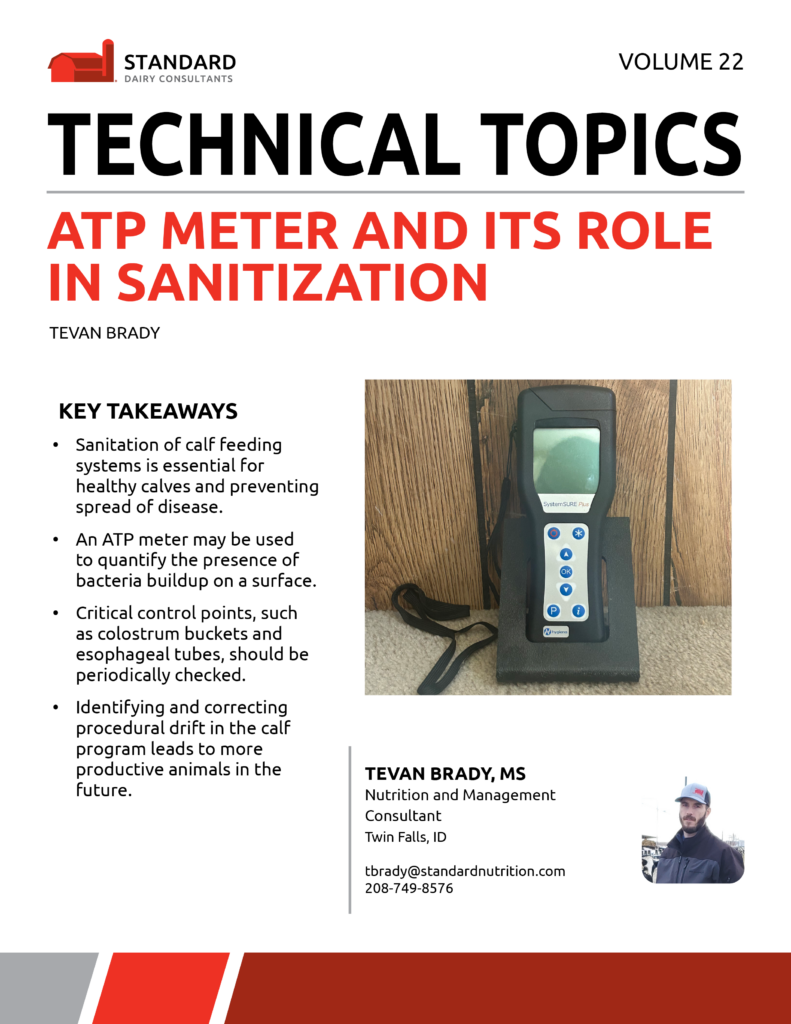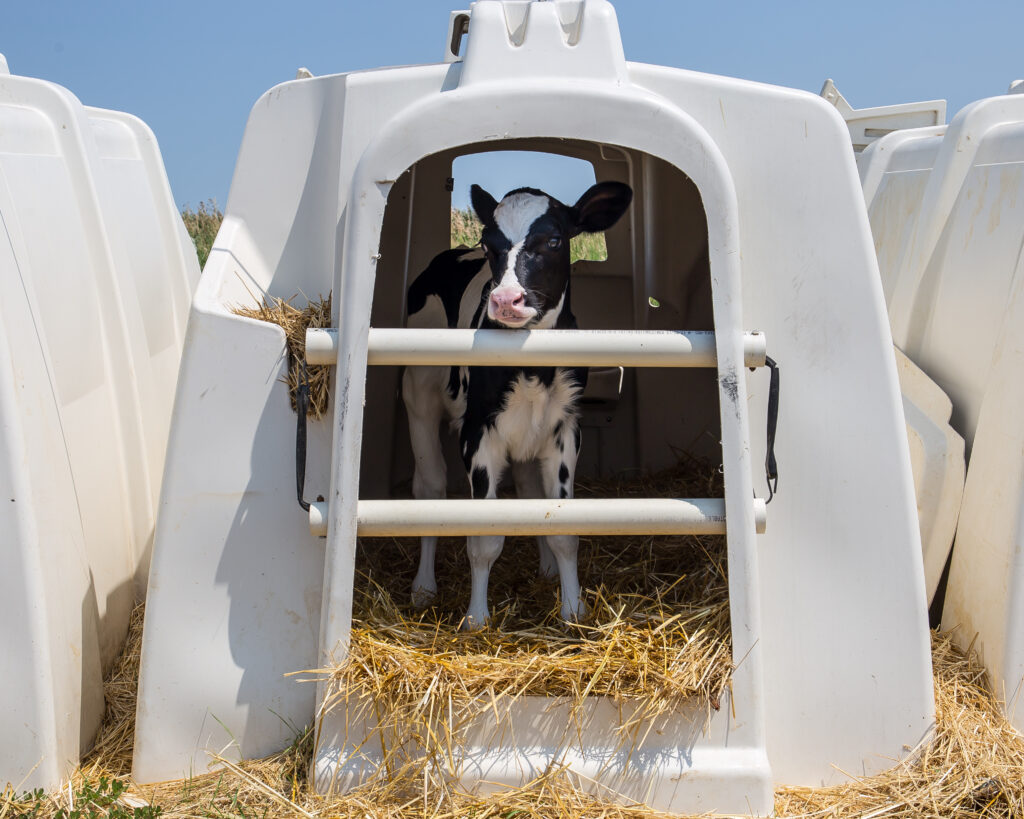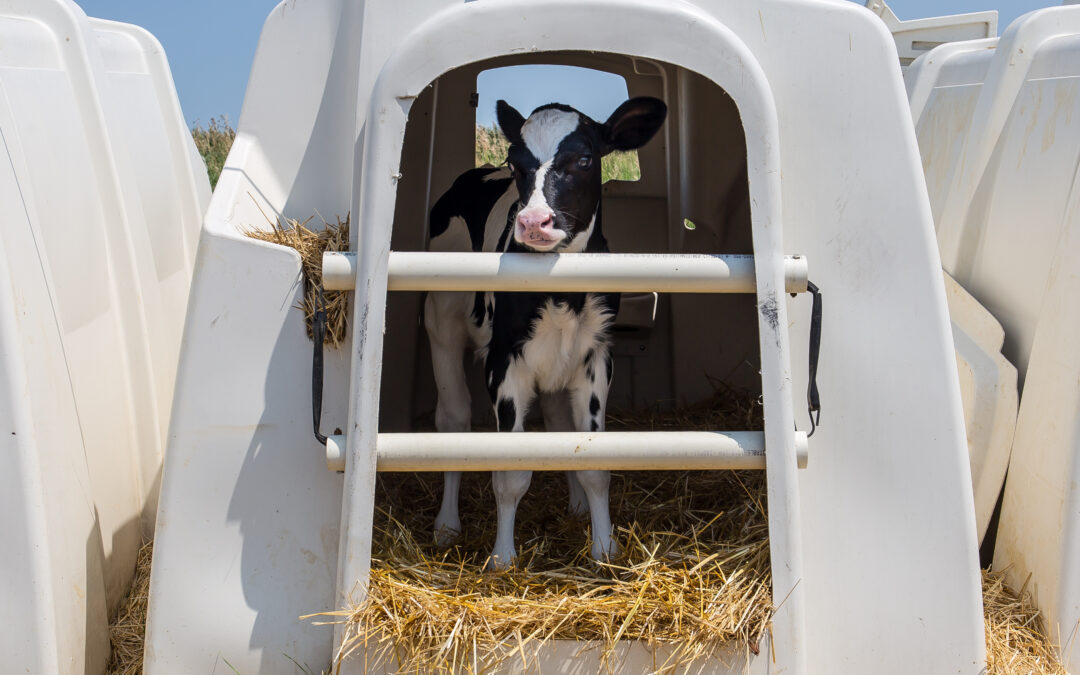Written by: Tevan Brady
KEY TAKEAWAYS IN THIS ISSUE OF TECHNICAL TOPICS:
- Sanitation of calf feeding systems is essential for healthy calves and preventing spread of disease.
- An ATP meter may be used to quantify the presence of bacteria buildup on a surface.
- Critical control points, such as colostrum buckets and esophageal tubes, should be periodically checked.
- Identifying and correcting procedural drift in the calf program leads to more productive animals in the future.

On a dairy, cleanliness is absolutely essential in the maternity and calf areas. Providing a clean environment for a newborn can save thousands of dollars in future treatment and medical expenses. Calves are born without an immune system, so early exposure to pathogens can be detrimental. By reducing the amount of exposure to pathogens, you can give calves the best chance of a healthy life.
One way that we can help is to establish sanitation protocols that can be consistently followed. By cleaning equipment that comes into contact with calves, we can ensure that they are exposed to as few pathogens as possible to help them stay healthy and growing. Most dairies have sanitation protocols in practice, however, as we all know, life on a dairy can get hectic. Frequently during these busy times, we can start to see “procedural drift” with the cleaning of equipment and unfortunately, we don’t catch it until death loss is abnormally high. By implementing the use of an ATP meter in our sanitation protocol, we can catch procedural drift before it goes on too long and leads to bigger problems.
WHAT IS AN ATP METER?
An ATP meter measures the presence of adenosine triphosphate (ATP). ATP is found in all living microbial cells. Therefore, by swabbing a surface, we can measure the amount of ATP found and use it as an indicator of contamination. After a sample has been collected, it is placed into the ATP meter and is exposed to chemicals that produce light. The meter then measures the intensity of the light and calculates the amount of ATP found. The results are measured in relative light units or RLUs. A low RLU means a small amount of contamination and a high RLU means a large amount of contamination was found on any given surface. For sanitation protocols, we are interested in the lowest RLU possible. As stated before, life on the dairy gets busy and procedural drift is bound to happen every now and then. Therefore, by implementing the use of the ATP meter, we may check periodically to see how well the sanitation procedures are being followed and are working.
WHERE ARE CRITICAL CONTROL POINTS FOR TESTING?
A critical control point is a certain point along the way of the calf feeding system where a biofilm (a complex structure where different bacterial colonies or other single cell types adhere to a given surface) might accumulate over time if routine cleanings are not occurring. Below are some examples:
- Colostrum buckets
- Lids to colostrum collection buckets
- Tubes that go on colostrum bucket lids
- Shoulder of colostrum bucket (in-between the wall and neck of the bucket)
- Bottles used to give milk/colostrum
- Nipples
- Esophageal tubes (inside both ends)
These are just a few areas that can be routinely swabbed to measure if cleanings are occurring. What’s important is to walk through your own calf feeding program and figure out what areas you want to include in your critical control points.
I have found that when critical control points start to yield high RLU results, it is time to investigate further and revisit the basics. I was once performing a regularly scheduled sanitation check at a dairy and the bottles and nipples both had RLUs above 3,000.
The buckets that colostrum was milked into also read well above 5,000 RLUs. For those of you wondering whether or not these readings are bad, just remember, the higher the RLU the dirtier the surface; typically, I want anything that I test under 50 RLUs at the max, and even then, if I can get everything below 10 RLUs, that’s even better. So, when I saw the results well above our goals, I began talking to the employee that was in charge of cleaning these items.
I spent a few minutes and had him show me how he was cleaning these pieces and found that he was skipping the step where a brush was required. I had him reclean a colostrum bucket and made sure that he added the use of a brush this time. Once he was done, I rechecked the bucket with the ATP meter and in just one cleaning (with the brush included) we went from 5,000 RLUs to 300. While this was still well above what I like to see, it was significantly better than before with just one cleaning that followed procedures. A few more good cleanings and we would be getting results of <10 in no time. Most of the time when I see high readings, the first place I check is if they are using a brush. It doesn’t matter how much or how strong the chemical we use is, if all we are doing is rinsing the equipment, we will never get rid of that biofilm that builds up. By adding a brush, you get the mechanical break up needed in order to get rid of the biofilm (which if present, will give a very high reading).

In conclusion, because calves are the future of your herd, it’s important to establish goals for your calf-rearing program and protocols to help reach the goals that you have. An ATP meter is just one instrument of many to help ensure that calves get the best start possible and go on to be healthy and productive members in the herd. As consultants, it is our responsibility to work as a team with each dairy and help identify problem areas and find remedies before they become detrimental. Having a conversation with your SDC Consultant may provide new ideas or insights for success with your calves. They can connect you to a large network of resources to ensure your calf area is set up to start your future milking herd off right.
TIPS FOR TRANSPORTATION OF PREWEANING CALVES
Written by: Chad Jenkins, PhD
As the costs associated with DIY calf rearing have become unviable for many dairy farms, it has become an increasingly common practice to outsource pre-weaned calves to heifer ranches. This practice often entails a lengthy ride in the trailer for baby calves which can be an inherently stressful event. Physiological stress contributes to immunosuppression, opening the door for increased risk of morbidity and mortality.
Because immunosuppression will occur in transport-stressed calves, “the best defense is a good offense” – high-quality colostrum must be provided early in life. An excellent colostrum program is always advisable, but special focus should be given to calves that will be exposed to the stressors of transport and comingling. Three critical factors including timing, quantity, and quality, should always be followed to ensure transfer of passive immunity to calves:
- Timing: colostrum should be fed as soon as possible after calving (within 3 hours) and fed a second time 12 hours after birth.
- Quantity: Calves should be fed colostrum at 12% to 15% body weight. For example, a 95 lb calf should receive around 11.4 lbs (5 ½ quarts) of colostrum in the first feeding.
- Quality: colostrum should be free of blood, dirt, etc., and test negative for Mycoplasma. It should contain at least 50 g of immunoglobulins (IgG) which equates to a Brix value of 22%.
Ideally before the transport process, calves should meet several criteria before being loaded onto the truck. First, calves should be at least 4 days old and a minimum of 50 lbs. Second, calves should have a clean, dry naval, and be able to stand up and walk unassisted. Third, calves should appear alert – depressed calves should be fed, rehydrated, and reevaluated.
When loading the truck, adequate space should be provided – 4 ft2/animal for calves up to 100 lbs, and 6 ft2 for calves up to 240 lbs. The floor of the trailer should be non-slip or covered with bedding material (extra bedding should be provided during cold weather). The trailer needs to be ventilated to provide fresh air. Calves should be gently and quietly loaded onto the truck. Calves need to be guided by hand one at a time when possible, as they do not respond well to being driven in the flight zone like older animals.
Several considerations should be made depending on the length of transport. A recent study (Bajus et al., 2023) measured the effect of transportation duration on lying behavior in young calves. Unsurprisingly, the researchers found that baby calves transported for longer durations (12 and 16 hours) spent less time lying down than calves transported for 6 hours or less and showed more signs of fatigue upon arrival. Therefore, calves on long trips should be fed within 5 to 6 hours of loading and should stop for rest, water, and feed after 16 hours.
A ride down the highway is undoubtedly a disquieting event for a newborn calf. Due to the risks associated with immunosuppression during this period, anything we can do to minimize transport-induced physiological stress is an investment in the future of the dairy herd.


